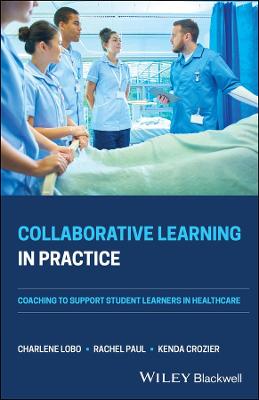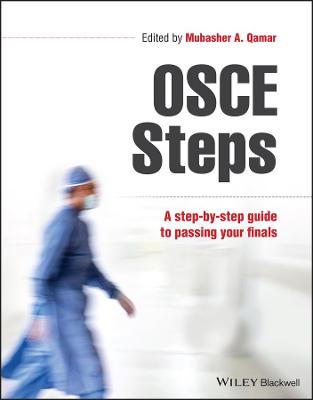Collaborative Learning in Practice
 -15%
portes grátis
-15%
portes grátis
Collaborative Learning in Practice
Coaching to Support Student Learners in Healthcare
Paul, Rachel; Crozier, Kenda; Lobo, Charlene
John Wiley and Sons Ltd
06/2021
272
Mole
Inglês
9781119695363
15 a 20 dias
348
Descrição não disponível.
Collaborator Biographies xiii
Foreword xix
Acknowledgements xxiii
Abbreviations xxv
About the Companion Website xxvii
Introduction 1
Kenda Crozier, Charlene Lobo and Rachel Paul
References 4
Glossary 5
Part I Evolution of CLiPTM 7
1 Changes in Practice Learning 9
Kenda Crozier and Charlene Lobo
Regulation of Nurse and Midwifery Education 9
The Return of the Apprentice 13
Clinical Practice Education 13
Establishing a Quality Learning Environment 15
References 17
2 Models of Practice Learning 20
Kenda Crozier
Practice Education 20
Practice Educator Roles 22
Faculty and Clinical Educators in Practice Settings 23
UK Mentorship Model 25
Hub and Spoke Models 28
The Student Perspective 29
Dedicated Education Units and Clinical Clusters 31
Real-Life Learning Wards 33
References 34
3 The CLiPTM Model 39
Charlene Lobo and Jonty Kenward
Domains of CLiP 43
Organisation of Learning 43
Coaching Philosophy 46
Principles of CLiP 47
Collaboration 47
Real-Life Learning 50
Time to Teach and Time to Learn 53
Stepping up and Stepping Back 55
Feedback and Assessment 57
References 61
4 System-Wide Approaches to CLiPTM 64
4.1 The South West CLiPTM Community Cluster Project 65
Jane Bunce
Background and Drivers 65
Why CLiP? 65
Project Overview 66
How Was CLiP Implemented in the Pilot Sites? 66
What Worked Well in the Pilot? 67
What Were the Main Challenges? 68
What Did We Decide we Would Do Differently Following the Pilot? 68
References 69
4.2 Lancashire Teaching Hospitals NHS Foundation Trust Implementation of the CLiPTM Model of Supervision 70
Jonty Kenward
Background and Drivers 70
Key Aims 71
Implementation 71
What Worked Well on Implementation 73
What Were the Main Challenges? 73
Top Tips 74
References 74
4.3 James Paget University NHS Foundation Trust Implementing the CLiPTM Model in Maternity Care 75
Kenda Crozier, Jodie Yerrell and Kirsty Tweedie
Introduction 75
How Was CLiP Implemented? 75
Timeline 79
Top Tips 79
References 80
5 Coaching Theory and Models 81
Rachel Paul
Coaching Theory 82
The Psychodynamic Coaching Approach 84
Cognitive Behavioural Coaching 86
Thinking errors to be aware of as a coach, educator, or student 89
Solutions Focused Coaching 90
Person-Centred Coaching 92
Gestalt and Coaching 93
Narrative Coaching 94
Psychological Development in Adulthood and Coaching 94
Positive Psychology 95
Being resilient...bouncebackability 96
Transactional Analysis 96
Some Conclusions 98
Key coaching skills and templates to experiment with 99
References 101
6 Evaluation 103
6.1 Plymouth University 104
Graham Williamson, Adele Kane and Jane Bunce
Background 104
Study 1: Collaborative Learning in Practice: A Systematic Review and Narrative Synthesis of the Research Evidence in Nurse Education 105
Study 2: 'Thinking like a Nurse'. Changing the Culture of Nursing Students' Clinical Learning: Implementing Collaborative Learning in Practice 107
Study 3: Investigating the Implementation of a Collaborative Learning in a Practice Model of Nurse Education in a Community Placement Cluster: A Qualitative Study 109
Study 4: Student Nurses, Increasing Placement Capacity and Patient Safety. A Retrospective Cohort Study 111
Summary and Key Messages 112
References 113
6.2 University of East Anglia 115
Antony Arthur, Rebekah Hill and Michael Woodward
Is it Better Than What We Did Before? The Challenge of Evaluating New Models of Practice Learning 115
References 116
Part II Coaching Application 117
7 Introduction to Coaching in Practice 119
Rachel Paul and Charlene Lobo
Language of Coaching 120
Thinking Errors 124
'Clean' Language 124
Re-Phrasing 128
The Learning Journey 129
Having Difficult Conversations 131
References 134
8 'A Coaching Day' 135
Rachel Paul, Charlene Lobo and Jonty Kenward
Scenario 1: Beginning the Shift, Managing and Negotiating Student-Led Learning 137
Scenario 2: One-to-One Supervision - Using a Coaching Approach to Assess/Make Judgements About Student Competence/the Level of Supervision Needed 143
Scenario 3: Checking in Midway Conversation 146
Scenario 4: End of a Shift - Using Coaching Approaches to Giving Feedback 150
9 Acute Adult Care - Orthopaedic and Trauma Ward 154
Rachel Paul, Charlene Lobo and Helen Bell
Scenario 1: A Positive Perspective of the 'Failing Student': Helping Students Understand Their Development Needs and Action Planning to Meet Them 156
Scenario 2: 'There is no such thing as a failing student' 161
Scenario 3: Solution-Focused Conversations and Supporting the Student's Emotional Intelligence to Help Turn a Negative Situation into Positive Learning 164
10 Community Nursing Case Study 169
Rachel Paul, Charlene Lobo and Theresa Walker
Community Nursing - City Team A 170
Scenario 1: Unconfident Student, Overcoming Obstacles to Learning 171
How the Situation Was Resolved 176
Scenario 2: Team Discord, Facilitating Teamworking 177
Scenario 3: Using Coaching Approaches in a Crisis 181
What Made This Incident Important to Learn From? 185
Clear Acknowledgement of Their Own Life Experiences as a Basis for Learning 185
11 Maternity Case Study 187
Kenda Crozier, Rachel Paul and Charlene Lobo
Scenario 1: Balancing Student-Led Learning and Client Care Needs 188
Timeline for the Student Journey 193
Scenario 2: Increasing Confidence 194
Scenario 3: Supporting Development and Action Planning 198
References 201
12 Mental Health 202
Rachel Paul, Charlene Lobo, Ronald Simpson and Helen Bell
Scenario 1: Managing a Disgruntled Student 204
Scenario 2: Managing Resistance to Learning 207
Scenario 3: Developing Team Support in an Unfair World 210
Scenario 4: Who Cares for the Supervisors? 214
References 218
Conclusion 220
Kenda Crozier, David Huggins, Charlene Lobo and Rachel Paul
The Importance of Sustainable Systems of Student Support 220
Increasing Student Numbers 221
Preparation for Coaching 223
Clinical Educator and Link Lecturer Support 224
New NMC Standards 224
Partly Applying the Model 225
Lessons Learned 226
Recommendations 227
References 228
Index 230
Foreword xix
Acknowledgements xxiii
Abbreviations xxv
About the Companion Website xxvii
Introduction 1
Kenda Crozier, Charlene Lobo and Rachel Paul
References 4
Glossary 5
Part I Evolution of CLiPTM 7
1 Changes in Practice Learning 9
Kenda Crozier and Charlene Lobo
Regulation of Nurse and Midwifery Education 9
The Return of the Apprentice 13
Clinical Practice Education 13
Establishing a Quality Learning Environment 15
References 17
2 Models of Practice Learning 20
Kenda Crozier
Practice Education 20
Practice Educator Roles 22
Faculty and Clinical Educators in Practice Settings 23
UK Mentorship Model 25
Hub and Spoke Models 28
The Student Perspective 29
Dedicated Education Units and Clinical Clusters 31
Real-Life Learning Wards 33
References 34
3 The CLiPTM Model 39
Charlene Lobo and Jonty Kenward
Domains of CLiP 43
Organisation of Learning 43
Coaching Philosophy 46
Principles of CLiP 47
Collaboration 47
Real-Life Learning 50
Time to Teach and Time to Learn 53
Stepping up and Stepping Back 55
Feedback and Assessment 57
References 61
4 System-Wide Approaches to CLiPTM 64
4.1 The South West CLiPTM Community Cluster Project 65
Jane Bunce
Background and Drivers 65
Why CLiP? 65
Project Overview 66
How Was CLiP Implemented in the Pilot Sites? 66
What Worked Well in the Pilot? 67
What Were the Main Challenges? 68
What Did We Decide we Would Do Differently Following the Pilot? 68
References 69
4.2 Lancashire Teaching Hospitals NHS Foundation Trust Implementation of the CLiPTM Model of Supervision 70
Jonty Kenward
Background and Drivers 70
Key Aims 71
Implementation 71
What Worked Well on Implementation 73
What Were the Main Challenges? 73
Top Tips 74
References 74
4.3 James Paget University NHS Foundation Trust Implementing the CLiPTM Model in Maternity Care 75
Kenda Crozier, Jodie Yerrell and Kirsty Tweedie
Introduction 75
How Was CLiP Implemented? 75
Timeline 79
Top Tips 79
References 80
5 Coaching Theory and Models 81
Rachel Paul
Coaching Theory 82
The Psychodynamic Coaching Approach 84
Cognitive Behavioural Coaching 86
Thinking errors to be aware of as a coach, educator, or student 89
Solutions Focused Coaching 90
Person-Centred Coaching 92
Gestalt and Coaching 93
Narrative Coaching 94
Psychological Development in Adulthood and Coaching 94
Positive Psychology 95
Being resilient...bouncebackability 96
Transactional Analysis 96
Some Conclusions 98
Key coaching skills and templates to experiment with 99
References 101
6 Evaluation 103
6.1 Plymouth University 104
Graham Williamson, Adele Kane and Jane Bunce
Background 104
Study 1: Collaborative Learning in Practice: A Systematic Review and Narrative Synthesis of the Research Evidence in Nurse Education 105
Study 2: 'Thinking like a Nurse'. Changing the Culture of Nursing Students' Clinical Learning: Implementing Collaborative Learning in Practice 107
Study 3: Investigating the Implementation of a Collaborative Learning in a Practice Model of Nurse Education in a Community Placement Cluster: A Qualitative Study 109
Study 4: Student Nurses, Increasing Placement Capacity and Patient Safety. A Retrospective Cohort Study 111
Summary and Key Messages 112
References 113
6.2 University of East Anglia 115
Antony Arthur, Rebekah Hill and Michael Woodward
Is it Better Than What We Did Before? The Challenge of Evaluating New Models of Practice Learning 115
References 116
Part II Coaching Application 117
7 Introduction to Coaching in Practice 119
Rachel Paul and Charlene Lobo
Language of Coaching 120
Thinking Errors 124
'Clean' Language 124
Re-Phrasing 128
The Learning Journey 129
Having Difficult Conversations 131
References 134
8 'A Coaching Day' 135
Rachel Paul, Charlene Lobo and Jonty Kenward
Scenario 1: Beginning the Shift, Managing and Negotiating Student-Led Learning 137
Scenario 2: One-to-One Supervision - Using a Coaching Approach to Assess/Make Judgements About Student Competence/the Level of Supervision Needed 143
Scenario 3: Checking in Midway Conversation 146
Scenario 4: End of a Shift - Using Coaching Approaches to Giving Feedback 150
9 Acute Adult Care - Orthopaedic and Trauma Ward 154
Rachel Paul, Charlene Lobo and Helen Bell
Scenario 1: A Positive Perspective of the 'Failing Student': Helping Students Understand Their Development Needs and Action Planning to Meet Them 156
Scenario 2: 'There is no such thing as a failing student' 161
Scenario 3: Solution-Focused Conversations and Supporting the Student's Emotional Intelligence to Help Turn a Negative Situation into Positive Learning 164
10 Community Nursing Case Study 169
Rachel Paul, Charlene Lobo and Theresa Walker
Community Nursing - City Team A 170
Scenario 1: Unconfident Student, Overcoming Obstacles to Learning 171
How the Situation Was Resolved 176
Scenario 2: Team Discord, Facilitating Teamworking 177
Scenario 3: Using Coaching Approaches in a Crisis 181
What Made This Incident Important to Learn From? 185
Clear Acknowledgement of Their Own Life Experiences as a Basis for Learning 185
11 Maternity Case Study 187
Kenda Crozier, Rachel Paul and Charlene Lobo
Scenario 1: Balancing Student-Led Learning and Client Care Needs 188
Timeline for the Student Journey 193
Scenario 2: Increasing Confidence 194
Scenario 3: Supporting Development and Action Planning 198
References 201
12 Mental Health 202
Rachel Paul, Charlene Lobo, Ronald Simpson and Helen Bell
Scenario 1: Managing a Disgruntled Student 204
Scenario 2: Managing Resistance to Learning 207
Scenario 3: Developing Team Support in an Unfair World 210
Scenario 4: Who Cares for the Supervisors? 214
References 218
Conclusion 220
Kenda Crozier, David Huggins, Charlene Lobo and Rachel Paul
The Importance of Sustainable Systems of Student Support 220
Increasing Student Numbers 221
Preparation for Coaching 223
Clinical Educator and Link Lecturer Support 224
New NMC Standards 224
Partly Applying the Model 225
Lessons Learned 226
Recommendations 227
References 228
Index 230
Este título pertence ao(s) assunto(s) indicados(s). Para ver outros títulos clique no assunto desejado.
collaborative learning practice; collaborative learning healthcare; collaborative learning nursing; CLiP model; CLiP nursing; CLiP healthcare; CLiP examples; CLiP cases; CLiP implementation; collaborative learning model; coach student learners
Collaborator Biographies xiii
Foreword xix
Acknowledgements xxiii
Abbreviations xxv
About the Companion Website xxvii
Introduction 1
Kenda Crozier, Charlene Lobo and Rachel Paul
References 4
Glossary 5
Part I Evolution of CLiPTM 7
1 Changes in Practice Learning 9
Kenda Crozier and Charlene Lobo
Regulation of Nurse and Midwifery Education 9
The Return of the Apprentice 13
Clinical Practice Education 13
Establishing a Quality Learning Environment 15
References 17
2 Models of Practice Learning 20
Kenda Crozier
Practice Education 20
Practice Educator Roles 22
Faculty and Clinical Educators in Practice Settings 23
UK Mentorship Model 25
Hub and Spoke Models 28
The Student Perspective 29
Dedicated Education Units and Clinical Clusters 31
Real-Life Learning Wards 33
References 34
3 The CLiPTM Model 39
Charlene Lobo and Jonty Kenward
Domains of CLiP 43
Organisation of Learning 43
Coaching Philosophy 46
Principles of CLiP 47
Collaboration 47
Real-Life Learning 50
Time to Teach and Time to Learn 53
Stepping up and Stepping Back 55
Feedback and Assessment 57
References 61
4 System-Wide Approaches to CLiPTM 64
4.1 The South West CLiPTM Community Cluster Project 65
Jane Bunce
Background and Drivers 65
Why CLiP? 65
Project Overview 66
How Was CLiP Implemented in the Pilot Sites? 66
What Worked Well in the Pilot? 67
What Were the Main Challenges? 68
What Did We Decide we Would Do Differently Following the Pilot? 68
References 69
4.2 Lancashire Teaching Hospitals NHS Foundation Trust Implementation of the CLiPTM Model of Supervision 70
Jonty Kenward
Background and Drivers 70
Key Aims 71
Implementation 71
What Worked Well on Implementation 73
What Were the Main Challenges? 73
Top Tips 74
References 74
4.3 James Paget University NHS Foundation Trust Implementing the CLiPTM Model in Maternity Care 75
Kenda Crozier, Jodie Yerrell and Kirsty Tweedie
Introduction 75
How Was CLiP Implemented? 75
Timeline 79
Top Tips 79
References 80
5 Coaching Theory and Models 81
Rachel Paul
Coaching Theory 82
The Psychodynamic Coaching Approach 84
Cognitive Behavioural Coaching 86
Thinking errors to be aware of as a coach, educator, or student 89
Solutions Focused Coaching 90
Person-Centred Coaching 92
Gestalt and Coaching 93
Narrative Coaching 94
Psychological Development in Adulthood and Coaching 94
Positive Psychology 95
Being resilient...bouncebackability 96
Transactional Analysis 96
Some Conclusions 98
Key coaching skills and templates to experiment with 99
References 101
6 Evaluation 103
6.1 Plymouth University 104
Graham Williamson, Adele Kane and Jane Bunce
Background 104
Study 1: Collaborative Learning in Practice: A Systematic Review and Narrative Synthesis of the Research Evidence in Nurse Education 105
Study 2: 'Thinking like a Nurse'. Changing the Culture of Nursing Students' Clinical Learning: Implementing Collaborative Learning in Practice 107
Study 3: Investigating the Implementation of a Collaborative Learning in a Practice Model of Nurse Education in a Community Placement Cluster: A Qualitative Study 109
Study 4: Student Nurses, Increasing Placement Capacity and Patient Safety. A Retrospective Cohort Study 111
Summary and Key Messages 112
References 113
6.2 University of East Anglia 115
Antony Arthur, Rebekah Hill and Michael Woodward
Is it Better Than What We Did Before? The Challenge of Evaluating New Models of Practice Learning 115
References 116
Part II Coaching Application 117
7 Introduction to Coaching in Practice 119
Rachel Paul and Charlene Lobo
Language of Coaching 120
Thinking Errors 124
'Clean' Language 124
Re-Phrasing 128
The Learning Journey 129
Having Difficult Conversations 131
References 134
8 'A Coaching Day' 135
Rachel Paul, Charlene Lobo and Jonty Kenward
Scenario 1: Beginning the Shift, Managing and Negotiating Student-Led Learning 137
Scenario 2: One-to-One Supervision - Using a Coaching Approach to Assess/Make Judgements About Student Competence/the Level of Supervision Needed 143
Scenario 3: Checking in Midway Conversation 146
Scenario 4: End of a Shift - Using Coaching Approaches to Giving Feedback 150
9 Acute Adult Care - Orthopaedic and Trauma Ward 154
Rachel Paul, Charlene Lobo and Helen Bell
Scenario 1: A Positive Perspective of the 'Failing Student': Helping Students Understand Their Development Needs and Action Planning to Meet Them 156
Scenario 2: 'There is no such thing as a failing student' 161
Scenario 3: Solution-Focused Conversations and Supporting the Student's Emotional Intelligence to Help Turn a Negative Situation into Positive Learning 164
10 Community Nursing Case Study 169
Rachel Paul, Charlene Lobo and Theresa Walker
Community Nursing - City Team A 170
Scenario 1: Unconfident Student, Overcoming Obstacles to Learning 171
How the Situation Was Resolved 176
Scenario 2: Team Discord, Facilitating Teamworking 177
Scenario 3: Using Coaching Approaches in a Crisis 181
What Made This Incident Important to Learn From? 185
Clear Acknowledgement of Their Own Life Experiences as a Basis for Learning 185
11 Maternity Case Study 187
Kenda Crozier, Rachel Paul and Charlene Lobo
Scenario 1: Balancing Student-Led Learning and Client Care Needs 188
Timeline for the Student Journey 193
Scenario 2: Increasing Confidence 194
Scenario 3: Supporting Development and Action Planning 198
References 201
12 Mental Health 202
Rachel Paul, Charlene Lobo, Ronald Simpson and Helen Bell
Scenario 1: Managing a Disgruntled Student 204
Scenario 2: Managing Resistance to Learning 207
Scenario 3: Developing Team Support in an Unfair World 210
Scenario 4: Who Cares for the Supervisors? 214
References 218
Conclusion 220
Kenda Crozier, David Huggins, Charlene Lobo and Rachel Paul
The Importance of Sustainable Systems of Student Support 220
Increasing Student Numbers 221
Preparation for Coaching 223
Clinical Educator and Link Lecturer Support 224
New NMC Standards 224
Partly Applying the Model 225
Lessons Learned 226
Recommendations 227
References 228
Index 230
Foreword xix
Acknowledgements xxiii
Abbreviations xxv
About the Companion Website xxvii
Introduction 1
Kenda Crozier, Charlene Lobo and Rachel Paul
References 4
Glossary 5
Part I Evolution of CLiPTM 7
1 Changes in Practice Learning 9
Kenda Crozier and Charlene Lobo
Regulation of Nurse and Midwifery Education 9
The Return of the Apprentice 13
Clinical Practice Education 13
Establishing a Quality Learning Environment 15
References 17
2 Models of Practice Learning 20
Kenda Crozier
Practice Education 20
Practice Educator Roles 22
Faculty and Clinical Educators in Practice Settings 23
UK Mentorship Model 25
Hub and Spoke Models 28
The Student Perspective 29
Dedicated Education Units and Clinical Clusters 31
Real-Life Learning Wards 33
References 34
3 The CLiPTM Model 39
Charlene Lobo and Jonty Kenward
Domains of CLiP 43
Organisation of Learning 43
Coaching Philosophy 46
Principles of CLiP 47
Collaboration 47
Real-Life Learning 50
Time to Teach and Time to Learn 53
Stepping up and Stepping Back 55
Feedback and Assessment 57
References 61
4 System-Wide Approaches to CLiPTM 64
4.1 The South West CLiPTM Community Cluster Project 65
Jane Bunce
Background and Drivers 65
Why CLiP? 65
Project Overview 66
How Was CLiP Implemented in the Pilot Sites? 66
What Worked Well in the Pilot? 67
What Were the Main Challenges? 68
What Did We Decide we Would Do Differently Following the Pilot? 68
References 69
4.2 Lancashire Teaching Hospitals NHS Foundation Trust Implementation of the CLiPTM Model of Supervision 70
Jonty Kenward
Background and Drivers 70
Key Aims 71
Implementation 71
What Worked Well on Implementation 73
What Were the Main Challenges? 73
Top Tips 74
References 74
4.3 James Paget University NHS Foundation Trust Implementing the CLiPTM Model in Maternity Care 75
Kenda Crozier, Jodie Yerrell and Kirsty Tweedie
Introduction 75
How Was CLiP Implemented? 75
Timeline 79
Top Tips 79
References 80
5 Coaching Theory and Models 81
Rachel Paul
Coaching Theory 82
The Psychodynamic Coaching Approach 84
Cognitive Behavioural Coaching 86
Thinking errors to be aware of as a coach, educator, or student 89
Solutions Focused Coaching 90
Person-Centred Coaching 92
Gestalt and Coaching 93
Narrative Coaching 94
Psychological Development in Adulthood and Coaching 94
Positive Psychology 95
Being resilient...bouncebackability 96
Transactional Analysis 96
Some Conclusions 98
Key coaching skills and templates to experiment with 99
References 101
6 Evaluation 103
6.1 Plymouth University 104
Graham Williamson, Adele Kane and Jane Bunce
Background 104
Study 1: Collaborative Learning in Practice: A Systematic Review and Narrative Synthesis of the Research Evidence in Nurse Education 105
Study 2: 'Thinking like a Nurse'. Changing the Culture of Nursing Students' Clinical Learning: Implementing Collaborative Learning in Practice 107
Study 3: Investigating the Implementation of a Collaborative Learning in a Practice Model of Nurse Education in a Community Placement Cluster: A Qualitative Study 109
Study 4: Student Nurses, Increasing Placement Capacity and Patient Safety. A Retrospective Cohort Study 111
Summary and Key Messages 112
References 113
6.2 University of East Anglia 115
Antony Arthur, Rebekah Hill and Michael Woodward
Is it Better Than What We Did Before? The Challenge of Evaluating New Models of Practice Learning 115
References 116
Part II Coaching Application 117
7 Introduction to Coaching in Practice 119
Rachel Paul and Charlene Lobo
Language of Coaching 120
Thinking Errors 124
'Clean' Language 124
Re-Phrasing 128
The Learning Journey 129
Having Difficult Conversations 131
References 134
8 'A Coaching Day' 135
Rachel Paul, Charlene Lobo and Jonty Kenward
Scenario 1: Beginning the Shift, Managing and Negotiating Student-Led Learning 137
Scenario 2: One-to-One Supervision - Using a Coaching Approach to Assess/Make Judgements About Student Competence/the Level of Supervision Needed 143
Scenario 3: Checking in Midway Conversation 146
Scenario 4: End of a Shift - Using Coaching Approaches to Giving Feedback 150
9 Acute Adult Care - Orthopaedic and Trauma Ward 154
Rachel Paul, Charlene Lobo and Helen Bell
Scenario 1: A Positive Perspective of the 'Failing Student': Helping Students Understand Their Development Needs and Action Planning to Meet Them 156
Scenario 2: 'There is no such thing as a failing student' 161
Scenario 3: Solution-Focused Conversations and Supporting the Student's Emotional Intelligence to Help Turn a Negative Situation into Positive Learning 164
10 Community Nursing Case Study 169
Rachel Paul, Charlene Lobo and Theresa Walker
Community Nursing - City Team A 170
Scenario 1: Unconfident Student, Overcoming Obstacles to Learning 171
How the Situation Was Resolved 176
Scenario 2: Team Discord, Facilitating Teamworking 177
Scenario 3: Using Coaching Approaches in a Crisis 181
What Made This Incident Important to Learn From? 185
Clear Acknowledgement of Their Own Life Experiences as a Basis for Learning 185
11 Maternity Case Study 187
Kenda Crozier, Rachel Paul and Charlene Lobo
Scenario 1: Balancing Student-Led Learning and Client Care Needs 188
Timeline for the Student Journey 193
Scenario 2: Increasing Confidence 194
Scenario 3: Supporting Development and Action Planning 198
References 201
12 Mental Health 202
Rachel Paul, Charlene Lobo, Ronald Simpson and Helen Bell
Scenario 1: Managing a Disgruntled Student 204
Scenario 2: Managing Resistance to Learning 207
Scenario 3: Developing Team Support in an Unfair World 210
Scenario 4: Who Cares for the Supervisors? 214
References 218
Conclusion 220
Kenda Crozier, David Huggins, Charlene Lobo and Rachel Paul
The Importance of Sustainable Systems of Student Support 220
Increasing Student Numbers 221
Preparation for Coaching 223
Clinical Educator and Link Lecturer Support 224
New NMC Standards 224
Partly Applying the Model 225
Lessons Learned 226
Recommendations 227
References 228
Index 230
Este título pertence ao(s) assunto(s) indicados(s). Para ver outros títulos clique no assunto desejado.







